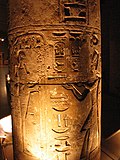Memphis, Egypt
Memphis was the ancient capital of the first nome of Lower Egypt, and of the Old Kingdom of Egypt from its foundation until around 2200 BC and later for shorter periods during the New Kingdom.[1] It was an administrative centre throughout ancient history.[2][3]
Its ancient Egyptian name was Ineb Hedj ("The White Walls"). The name "Memphis" (Μέμφις) is the Greek of the Egyptian name of the pyramid of Pepi I (6th dynasty), which was Men-nefer,[4] and became Menfe in Coptic. The modern cities and towns of Mit Rahina, Dahshur, Saqqara, Abusir, Abu Gorab, and Zawyet el'Aryan, south of Cairo, all lie within the administrative borders of historical Memphis (29°50′58.8″N 31°15′15.4″E / 29.849667°N 31.254278°E).
Memphis was also known in Ancient Egypt as Ankh Tawy ("That which binds the Two Lands") because of the strategic position of the city between Upper and Lower Egypt.
The ruins of Memphis are 20 km (12 miles) south of Cairo, on the west bank of the Nile.
In the Bible, Memphis is called Moph or Noph.
Memphis, Egypt Media
Memphis and its necropolis Saqqara as seen from the International Space Station
Ritualistic object depicting the god Nefertem, who was mainly worshipped in Memphis, The Walters Art Museum
Relief representing the High Priest of Ptah, Shoshenq
Alexander at the Temple of Apis in Memphis, by Andre Castaigne (1898–1899)
References
- ↑ Katheryn A. Bard, Encyclopedia of the Archaeology of Ancient Egypt, Routledge 1999, p.694
- ↑ Lynn Meskell, Private Life in New Kingdom Egypt, Princeton University Press 2002, p.34
- ↑ Ian Shaw, The Oxford History of Ancient Egypt, Oxford University Press 2003, p.279
- ↑ Bridget McDermott, Decoding Egyptian Hieroglyphs: How to Read the Secret Language of the Pharaohs, Chronicle Books 2001, p.130
Sources
- Baines & Malek Cultural Atlas of Ancient Egypt, 2000. ISBN 0-8160-4036-2
Other websites
| Preceded by -- |
Capital of Egypt 3100 BC - 2180 BC |
Succeeded by Herakleopolis |
29°50′40.8″N 31°15′3.3″E / 29.844667°N 31.250917°E
![]()









